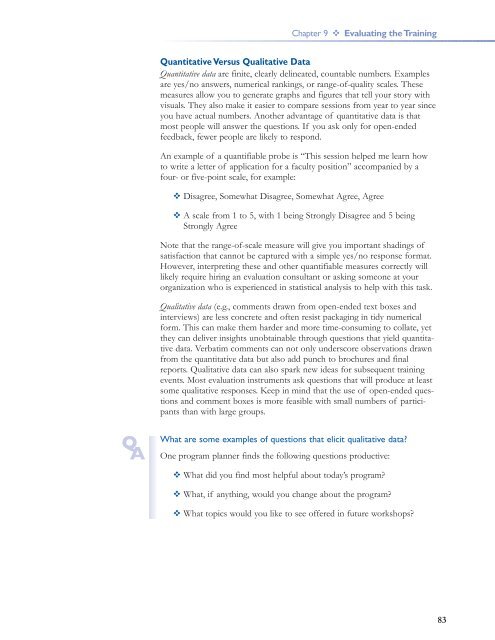Training Scientists to Make the Right Moves - Howard Hughes ...
Training Scientists to Make the Right Moves - Howard Hughes ...
Training Scientists to Make the Right Moves - Howard Hughes ...
Create successful ePaper yourself
Turn your PDF publications into a flip-book with our unique Google optimized e-Paper software.
Chapter 9 Evaluating <strong>the</strong> <strong>Training</strong><br />
At a Glance<br />
“”<br />
QA<br />
At a Glance<br />
Quantitative Versus Qualitative Data<br />
Quantitative data are finite, clearly delineated, countable numbers. Examples<br />
are yes/no answers, numerical rankings, or range-of-quality scales. These<br />
measures allow you <strong>to</strong> generate graphs and figures that tell your s<strong>to</strong>ry with<br />
visuals. They also make it easier <strong>to</strong> compare sessions from year <strong>to</strong> year since<br />
you have actual numbers. Ano<strong>the</strong>r advantage of quantitative data is that<br />
most people will answer <strong>the</strong> questions. If you ask only for open-ended<br />
feedback, fewer people are likely <strong>to</strong> respond.<br />
An example of a quantifiable probe is “This session helped me learn how<br />
<strong>to</strong> write a letter of application for a faculty position” accompanied by a<br />
four- or five-point scale, for example:<br />
Disagree, Somewhat Disagree, Somewhat Agree, Agree<br />
A scale from 1 <strong>to</strong> 5, with 1 being Strongly Disagree and 5 being<br />
Strongly Agree<br />
Note that <strong>the</strong> range-of-scale measure will give you important shadings of<br />
satisfaction that cannot be captured with a simple yes/no response format.<br />
However, interpreting <strong>the</strong>se and o<strong>the</strong>r quantifiable measures correctly will<br />
likely require hiring an evaluation consultant or asking someone at your<br />
organization who is experienced in statistical analysis <strong>to</strong> help with this task.<br />
Qualitative data (e.g., comments drawn from open-ended text boxes and<br />
interviews) are less concrete and often resist packaging in tidy numerical<br />
form. This can make <strong>the</strong>m harder and more time-consuming <strong>to</strong> collate, yet<br />
<strong>the</strong>y can deliver insights unobtainable through questions that yield quantitative<br />
data. Verbatim comments can not only underscore observations drawn<br />
from <strong>the</strong> quantitative data but also add punch <strong>to</strong> brochures and final<br />
reports. Qualitative data can also spark new ideas for subsequent training<br />
events. Most evaluation instruments ask questions that will produce at least<br />
some qualitative responses. Keep in mind that <strong>the</strong> use of open-ended questions<br />
and comment boxes is more feasible with small numbers of participants<br />
than with large groups.<br />
Chapter One<br />
What are some examples of questions that elicit qualitative data?<br />
One program planner finds <strong>the</strong> following questions productive:<br />
What did you find most helpful about <strong>to</strong>day’s program?<br />
What, if anything, would you change about <strong>the</strong> program?<br />
What <strong>to</strong>pics would you like <strong>to</strong> see offered in future workshops?<br />
83
















